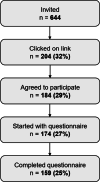Need for numbers: assessing cancer survivors' needs for personalized and generic statistical information
- PMID: 36199092
- PMCID: PMC9535944
- DOI: 10.1186/s12911-022-02005-2
Need for numbers: assessing cancer survivors' needs for personalized and generic statistical information
Abstract
Background: Statistical information (e.g., on long-term survival or side effects) may be valuable for healthcare providers to share with their patients to facilitate shared decision making on treatment options. In this pre-registered study, we assessed cancer survivors' need for generic (population-based) versus personalized (tailored towards patient/tumor characteristics) statistical information after their diagnosis. We examined how information coping style, subjective numeracy, and anxiety levels of survivors relate to these needs and identified statistical need profiles. Additionally, we qualitatively explored survivors' considerations for (not) wanting statistical information.
Methods: Cancer survivors' need for statistics regarding incidence, survival, recurrence, side effects and quality of life were assessed with an online questionnaire. For each of these topics, survivors were asked to think back to their first cancer diagnosis and to indicate their need for generic and personalized statistics on a 4-point scale ('not at all'- 'very much'). Associations between information coping style, subjective numeracy, and anxiety with need for generic and personalized statistics were examined with Pearson's correlations. Statistical need profiles were identified using latent class analysis. Considerations for (not) wanting statistics were analyzed qualitatively.
Results: Overall, cancer survivors (n = 174) had a higher need for personalized than for generic statistics (p < .001, d = 0.74). Need for personalized statistics was associated with higher subjective numeracy (r = .29) and an information-seeking coping style (r = .41). Three statistical need profiles were identified (1) a strong need for both generic and personalized statistics (34%), (2) a stronger need for personalized than for generic statistics (55%), and (3) a little need for both generic and personalized statistics (11%). Considerations for wanting personalized cancer statistics ranged from feelings of being in control to making better informed decisions about treatment. Considerations for not wanting statistics related to negative experience with statistics and to the unpredictability of future events for individual patients.
Conclusions: In light of the increased possibilities for using personalized statistics in clinical practice and decision aids, it appears that most cancer survivors want personalized statistical information during treatment decision-making. Subjective numeracy and information coping style seem important factors influencing this need. We encourage further development and implementation of data-driven personalized decision support technologies in oncological care to support patients in treatment decision making.
Keywords: Cancer statistics; Patient information needs; Patient-centered healthcare; Personalization; Risk communication; Shared decision-making; Tailoring.
© 2022. The Author(s).
Conflict of interest statement
The authors declare that they have no competing interests.
Figures




References
Publication types
MeSH terms
LinkOut - more resources
Full Text Sources
Medical

